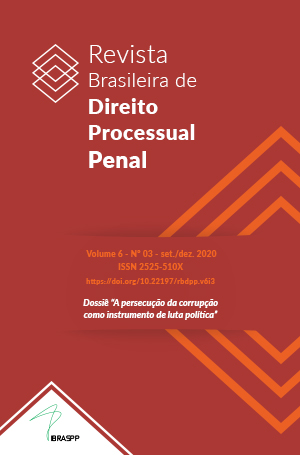La doctrina de la soberanía dual en la jurisprudencia de la Corte Suprema de Estados Unidos
DOI:
https://doi.org/10.22197/rbdpp.v6i3.297Palavras-chave:
Ne bis in idem, persecuciones múltiples, doctrina de la soberanía dual.Resumo
Bajo la doctrina de la soberanía dual, la Corte Suprema ha aceptado que diferentes soberanos persigan penalmente a la misma persona sin violar la cláusula double jeopardy por los mismos hechos si es que la conducta de tal individuo infringió las leyes de cada soberano. El presente artículo tiene por objeto estudiar la evolución de la doctrina de la soberanía dual en la jurisprudencia de la Corte Suprema. Además, el artículo aborda las protecciones actualmente existentes en contra de eventuales abusos que puedan ser cometidos bajo la doctrina de la soberanía dual, tales como la “sham exception” y la “Petite Policy”. Finalmente, y dado que las anteriores protecciones han sido consideradas insuficientes, el artículo explora brevemente la posibilidad de aplicar la Octava Enmienda como una protección adicional en contra de eventuales abusos que la aplicación de la doctrina de la soberanía dual pueda generar.
Downloads
Referências
ADLER, Adam. Dual Sovereignty, Due Process, and Duplicative Punishment: A New Solution to an Old Problem, Yale Law Journal, v. 124, n. 2, 2014.
ALBIN, Laurel Anne. Notes: Constitutional Limitations of Civil in Rem Forfeiture and the Double Jeopardy Dilemma: Civil in Rem Forfeiture Constitutes Punishment and Is Subject to Excessive Fines Analysis. Aravanis v. Somerset County, 339 Md. 644, 664 A.2d 888 (1995), Cert. Denied, 116 S. Ct. 916 (1996), University of Baltimore Law Review, v. 26, n. 1, 1996.
ALLEN, Ronald and Ratnaswamy, John. Heath v. Alabama: A Case Study of Doctrine and Rationality in the Supreme Court, Journal of Criminal Law and Criminology, v. 76, n. 4, 1985.
BAKER, Roozbeh. Proportionality in the Criminal Law: The Differing American versus Canadian Approaches to Punishment, University of Miami Inter-American Law Review, v. 39, n. 3, 2008.
BOYLE, Richard. Double Jeopardy and Dual Sovereignty: The Impact of Benton v. Maryland on Successive Prosecution for the Same Offense by State and Federal Governments, Indiana Law Journal, v. 46, n. 3, 1971.
BRAUN, Daniel. Praying to False Sovereigns: The Rule Permitting Successive Prosecutions in the Age of Cooperative Federalism, American Journal of Criminal Law, v. 20, n. 1, 1992.
BRICKMAN, Jay. The Dual Sovereignty Doctrine and Successive State Prosecutions: Health v. Alabama, Chicago-Kent Law Review, v. 63, n. 1, 1987.
CLAPP, Randy. Eighth Amendment Proportionality, American Journal of Criminal Law, v. 7, n. 2, 1979.
COLANGELO, Anthony, Double Jeopardy and Multiple Sovereigns: A Jurisdictional Theory, Washington University Law Review, v. 86, n. 4, 2009.
COONEY, John. Multi-Jurisdictional and Successive Prosecution of Environmental Crimes: The Case for a Consistent Approach, Journal of Criminal Law and Criminology, v. 96, n. 2, 2006.
CRANMAN, Erin. The Dual Sovereignty Exception to Double Jeopardy: A Champion of Justice or a Violation of a Fundamental Right, Emory International Law Review, v. 14, n. 3, 2000.
DAWSON, Michael. Popular Sovereignty, Double Jeopardy, and the Dual Sovereignty Doctrine, Yale Law Journal, v. 102, n. 1, 1992.
ESCOBAR, Javier. Double Jeopardy and Dual Sovereignty Doctrine: Gamble v. United States, Revista de Derecho, v. 20, n. 2, 2019.
FISHER, Walter. Double Jeopardy, Two Sovereignties and the Intruding Constitution, The University of Chicago Law Review, v. 28, n. 4, 1961.
GRANUCCI, Anthony. "Nor Cruel and Unusual Punishments Inflicted:" The Original Meaning, California Law Review, v. 57, n. 4, 1969.
HOFFMANN, Joseph. The Cruel and Unusual Punishment Clause. A Limit on the Power to Punish or Constitutional Rhetoric? In: BODENHAMER, David and ELY, James (Eds.). The Bill of Rights in Modern America, Indiana University Press, 2008.
JONES, Margaret, What Constitutes Double Jeopardy, Journal of Criminal Law and Criminology, v. 38, n. 4, 1948.
KING, James. The Problem of Double Jeopardy in Successive Federal-State Prosecutions: A Fifth Amendment Solution, Stanford Law Review, v. 31, n. 3, 1979.
KING, Nancy. Portioning Punishment: Constitutional Limits on Successive and Excessive Penalties, University of Pennsylvania Law Review, v. 144, n. 1, 1995.
KOKLYS, Andrea. Second Chance for Justice: Reevaluation of the United States Double Jeopardy Standard, John Marshall Law Review, v. 40, n. 1, 2006.
LEE, Evan. The Dual Sovereignty Exception to Double Jeopardy: In the Wake of Garcia v. San Antonio Metropolitan Transit Authority, New England Law Review, v. 22, n. 1, 1987.
LEE, Youngjae. The Constitutional Right against Excessive Punishment, Virginia Law Review, v. 91, n. 3, 2005.
LOPEZ, Dax. Not Twice for the Same: How the Dual Sovereignty Doctrine Is Used to Circumvent Non Bis in Idem, Vanderbilt Journal of Transnational Law, v. 33, n. 5, 2000.
MATZ, Robert. Dual Sovereignty and the Double Jeopardy Clause: If at First You Don't Convict, Try, Try, Again, Fordham Urban Law Journal, v. 24, n. 2, 1997.
MCANINCH, William. Unfolding the Law of Double Jeopardy, South Carolina Law Review, v. 44, n. 3, 1993.
MERKL, Taryn. The Federalization of Criminal Law and Double Jeopardy, Columbia Human Rights Law Review, v. 31, n. 1, 1999.
MULLEN, Kayla. Gamble v. United States: A Commentary. Duke Journal of Constitutional Law & Public Policy, v. 14, n. 1, 2019.
OWSLEY, David. Accepting the Dual Sovereignty Exception to Double Jeopardy: A Hard Case Study, Washington University Law Review, v. 81, n. 3, 2003.
PODGOR, Ellen. Department of Justice Guidelines: Balancing Discretionary Justice, Cornell Journal of Law and Public Policy, v. 13, n. 2, 2004.
PRINCIPATO, Daniel. Defining the Sovereign in Dual Sovereignty: Does the Protection against Double Jeopardy Bar Successive Prosecutions in National and International Courts, Cornell International Law Journal, v. 47, n. 3, 2014.
REED, Akhil and MARCUS, Jonathan. Double Jeopardy Law After Rodney King, Columbia Law Review, v. 95, n. 1, 1995.
REINHART, Douglas. Applying the Eighth Amendment to Civil Forfeiture after Austin v. United States: Excessiveness and Proportionality, William & Mary Law Review, v. 36, n. 1, 1994.
ROOKER, John. Crime and Punishment: The Eighth Amendment's Proportionality Guarantee after Harmelin v. Michigan, Brigham Young University Journal of Public Law, v. 7, n. 1, 1992.
RUDSTEIN, David. Double Jeopardy. A Reference Guide to the United States Constitution, Praeger, 2004.
RUDSTEIN, David. A Brief History of the Fifth Amendment Guarantee Against Double Jeopardy, William & Mary Bill of Rights Journal, v. 14, n. 1, 2005.
SIGLER, Jay. A History of Double Jeopardy, American Journal of Legal History, v. 7, n. 4, 1963.
SIGLER, Jay. Federal Double Jeopardy Policy, Vanderbilt Law Review, v. 19, n. 2, 1966.
STONER, Ray. Double Jeopardy and Dual Sovereignty: A Critical Analysis, William & Mary Law Review, v. 11, n. 4, 1970.
SUMMERS, Brian. Double Jeopardy: Rethinking the Parameters of the Multiplicity Prohibition, Ohio State Law Journal, v. 56, n. 5, 1995, p. 1595.
THOMAS III, George. Double Jeopardy. The History, the Law, New York University Press, 1998.
WOODS, Christina. Comments: The Dual Sovereignty Exception to Double Jeopardy: An Unnecessary Loophole, University of Baltimore Law Review, v. 24, n. 1, 1994.
Downloads
Publicado
Edição
Seção
Licença
Os direitos autorais dos artigos publicados são do autor, com direitos do periódico sobre a primeira publicação, impressa e/ou digital.
Os autores somente poderão utilizar os mesmos resultados em outras publicações indicando claramente este periódico como o meio da publicação original. Se não houver tal indicação, considerar-se-á situação de auto-plágio.
- Portanto, a reprodução, total ou parcial, dos artigos aqui publicados fica sujeita à expressa menção da procedência de sua publicação neste periódico, citando-se o volume e o número dessa publicação, além do link DOI para referência cruzada. Para efeitos legais, deve ser consignada a fonte de publicação original.
Por se tratar de periódico de acesso aberto, permite-se o uso gratuito dos artigos em aplicações educacionais e científicas desde que citada a fonte, conforme a licença da Creative Commons.
![]()
A partir de 2022, os artigos publicados na RDPP estão licenciados com uma Licença Creative Commons Atribuição 4.0 Internacional. Os artigos puliicados até 2021 adotaram a Licença Creative Commons Atribuição-NãoComercial 4.0 Internacional.
---------------
Arquivamento e distribuição
Permite-se sem restrições o arquivamento do PDF final publicado, em qualquer servidor de acesso aberto, indexador, repositório ou site pessoal, como Academia.edu e ResearchGate.
















